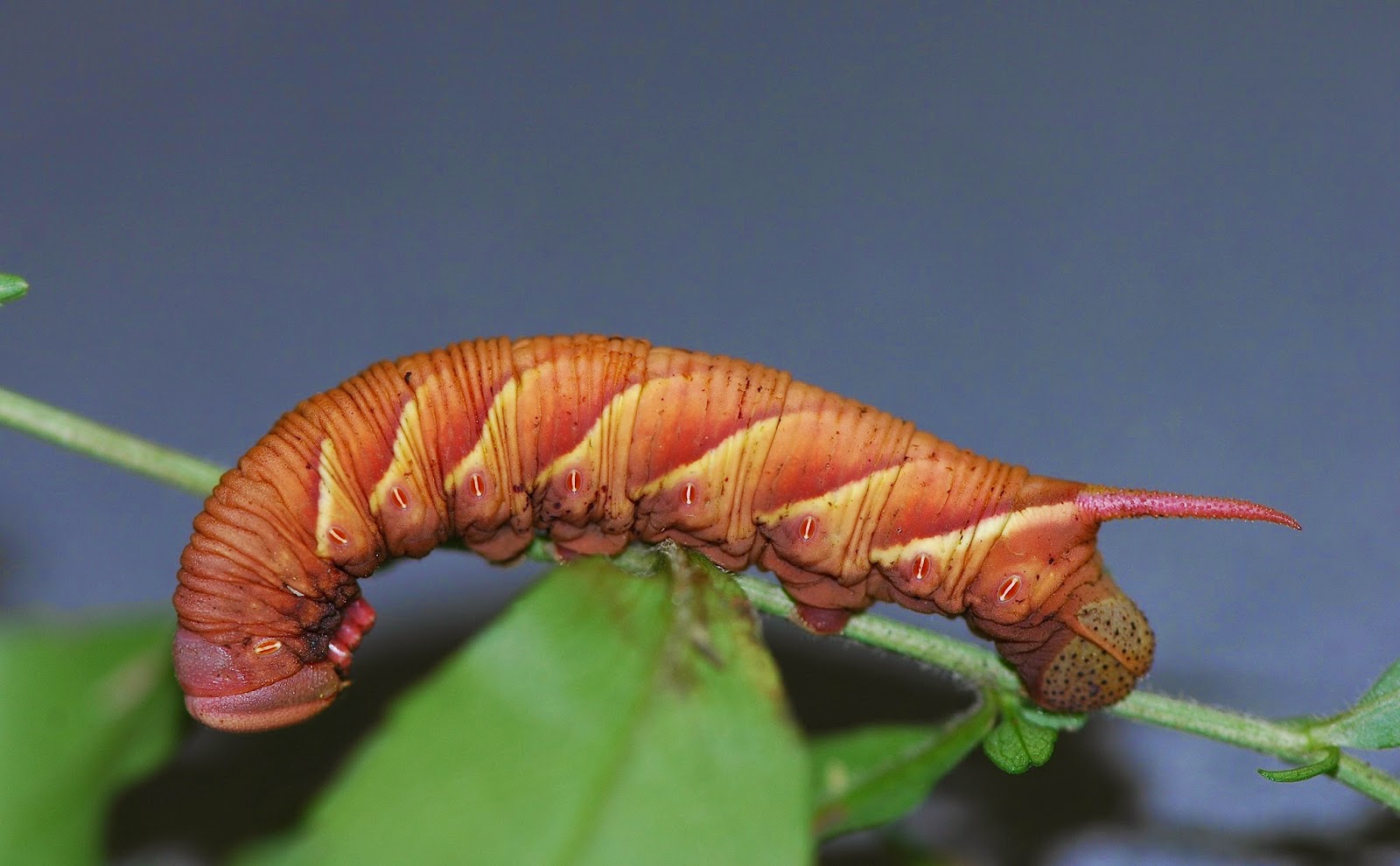Fall Webworm, Hyphantria cunea. The two rows of black spots, and widely spreading hairs help to identify it. Once they reach their last instar, they tend to wander away from their web.
Most people have probably noticed them when they surround an entire branch with their large webs. Be aware, Fall webworms can be found throughout the summer, not just now. They stick to the end branches, so no real serious damage occurs to the trees they feed on.
A bright orange head with yellow and black blotches. These tiny early instars did not look familiar to me. It is always best to look for more, hopefully older ones, to figure out what it is.
Sure enough, I found some bigger ones. A brilliantly colored mature form with rows of orange spots on back, and a row of white on the side. This is the Gold Moth, Basilodes pepita, an Owlet Moth. Its food plant is Wingstem, Verbesina alternifolia.
A tiny Inchworm hangs by a silken thread while grasping another plant. Even though I have several caterpillar guides, including one just on Inchworms, these never seem to match up to a sure thing. That green line down the back, yellow lines on either side, and those fake eyes lead me to a Macaria species of some sort. Who knows for sure. I just don't want to bother Dave Wagner every time I take a photo of one.
Inchworms are different than other caterpillars because they lack prolegs in the middle of the abdomen. There are usually two at the rear.
Here is the same caterpillar up front. That crest on the head, followed by two raised bumps, means this could be in the genus Biston or maybe Hethemia.
I also came across a few Hornworms. This is the Hog Sphinx, Darapsa myron. Its lime green color is flanked by a row of white fish head shapes. In the last instar, it is not unusual to see the first couple abdominal segments swollen like this. Its food plant gives rise to a second common name, the Virginia Creeper Sphinx.
There are many hornworms that sport light colored lines on each abdominal segment. The wide pale stripe on the face, and the pink horn, lead us to the Waved Sphinx, Ceratomia undulosa. This caterpillar is done feeding. When mature, many species turn from green to orange or brown before pupating.
Many small white beads circle the body of this caterpillar. The pink spots interspersed on the back make it quite striking. It's the Walnut Sphinx, Amorpha juglandis, found feeding on both Walnut and Hickory.
The pink-red spots are variable on the back, so take a closer look at the front end. It has a pointy cone head or bishops cap.
At the other end, the horn appears to be bleeding onto the body. It is just a color pattern, although this caterpillars horn is actually broken off.
A quick shot of a Luna Moth larvae, Actias luna. When disturbed, many caterpillars stop feeding and rear back their heads like this.
One of the ways I find so many caterpillars is to see beyond the obvious. What most people might pass off as just part of the changing leaf tip, I look closer. Sometimes, for whatever reason, things don't seem quite right.
By simply turning the leaf over, I could see it was one of my slugs. This is Parasa chloris, the Smaller Green Parasa. The green is in reference to the color on the moth. This caterpillar always looks to me like it's somewhat deflated or blob like. It rides flat and low from head to tail. Due to the shape of the upper portions, it's often nicknamed a 'junk', after a Chinese fishing boat.
Another favorite slug of mine. Oh, who am I kidding, in this family, they're all favorites. The Skiff Moth, Prolimacodes badia. The amount of brown and white patching will vary, and is said to mimic decaying portions of a leaf.
On the other side there are two white spots. The one in the middle is actually the egg of a wasp, as this caterpillar has been parasitized.
Falling from trees, in huge numbers right now, are the tiger moths. This one was also crawling around on Wingstem. It's Spilosoma virginica, The Virginia Tiger or Yellow Woolybear.
Long black antennae and bright orange eyes. Well actually, they are neither, but possibly intimidating to a potential predator. This is the Pale or Banded Tiger Moth, Halysidota tessellaris.
My imagination sometimes goes off the deep end. I think this looks like a Sheep Dog laying down with its legs out.
If we are doing Tiger Moths, we have to include the classic Common Woolybear, Pyrrharctia isabella. These, like many Tiger Moths, will overwinter as a caterpillar, and hatch out next year. The adult is a rather drab mixture of yellow and orange, and is known as the Isabella Moth.
The large round leaves of the Redbud, Cercis canadensis, are very common along the edges of most woodlands.
When I see a Redbud leaf folded in half, it grabs my attention, especially one that appears white. Obviously there is some activity going on here. Perhaps a leaf miner or skeletonizer.
Upon opening it, you can see the silken strands that were holding the leaf together. A small black and white caterpillar has been feeding on just the soft tissue. This is the Redbud Leaf-folder, Fascista cercerisella, a member of the micro moth family Gelechiidae.
Caterpillars are easy to find. With a few exceptions, most of these were taken in a 100 yard path along the edge of a woods. A day after posting this I found another. If I get a few more species, I'll add them to the bottom of this post in October. On second thought, look for more in my Fall Insect Walk post coming soon.











































































